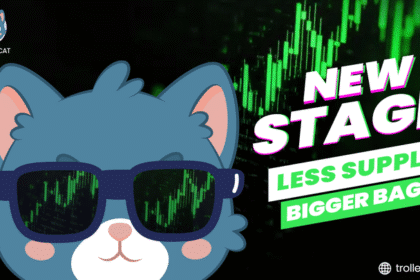Tron has officially outpaced Ethereum in daily USDT (Tether) transfer volume, handling $23.4 billion compared to Ethereum’s $10.5 billion, according to new data from CryptoQuant.
The achievement cements Tron’s rising dominance in the stablecoin settlement layer, especially in high-throughput, low-cost environments such as cross-border payments and retail transactions.
“Tron is winning where it matters most for stablecoins, cost efficiency and speed,” noted a researcher from CryptoQuant.
Key Stats: Tron (USDT) Stablecoin Surge in 2025
Daily USDT Transfer Volume on Tron: $23.4 billion
Daily USDT Transfer Volume on Ethereum: $10.5 billion
Circulating USDT Supply on Tron: $75.8 billion
2025 USDT Supply Growth on Tron: +27% (~$16 billion)
Current TRX Price: $0.272
TRX RSI (Relative Strength Index): 66.21 (bullish momentum)
The increase in transfer volume aligns with an explosive 27% growth in Tron’s USDT supply this year, reflecting shifting user preference toward networks with lower transaction fees and faster processing times.

Why Tron is Gaining Ground
Tron’s performance is not just statistical, it’s strategic. The protocol’s low gas fees, high throughput, and widespread adoption in emerging markets have made it the top choice for high-frequency stablecoin usage.
Three key reasons behind the shift:
Transaction Costs: Tron fees are near-zero, compared to Ethereum’s higher and variable gas costs.
Speed: Tron processes up to 2,000 transactions per second, far exceeding Ethereum’s current TPS.
Adoption in DeFi-lite Use Cases: Tron’s simplicity attracts users focused purely on USDT transactions, not complex DeFi.
“Tron isn’t trying to replace Ethereum in DeFi. It’s becoming the Visa of crypto transfers,” said blockchain analyst Victor L.
Ethereum Still Rules DeFi and Institutions
Despite being overtaken in USDT transfer volume, Ethereum remains the undisputed leader in decentralized finance (DeFi), housing over 70% of all DeFi TVL (Total Value Locked) and still attracting the lion’s share of institutional capital.
Ethereum also boasts broader adoption across:
Lending protocols
DEXs (like Uniswap and Curve)
Ethereum-based Layer 2 scaling solutions
Smart contract standardization (ERC-20, ERC-721)
The current divergence shows ecosystem specialization, Tron for stablecoin retail transfers, Ethereum for programmable finance and complex assets.

TRX Price Momentum Builds on Positive On-Chain Metrics
Tron’s native token TRX is riding the wave of network activity. TRX is trading at $0.272, up over 10% in May, with a bullish RSI reading of 66.21 indicating continued buying strength.
Whale activity, exchange outflows, and staking growth are contributing to increased demand. With stablecoin utility rising, TRX may continue to benefit as a gas token driving transactional flow on the Tron network.
Ethereum vs Tron: A Functional Split in Use Cases
| Metric | Ethereum | Tron |
|---|---|---|
| Daily USDT Transfer Volume | $10.5 Billion | $23.4 Billion |
| Avg. Transaction Fee | $2.10 – $8.50 | <$0.01 |
| DeFi Total Value Locked | $96 Billion | ~$9 Billion |
| Speed (TPS) | ~30 | ~2,000 |
| Main Use Case | DeFi, NFTs, Institutions | Stablecoin Transfers |
This chart makes one thing clear: Ethereum and Tron are diverging, not competing directly. Each is carving out its niche in the evolving blockchain economy.
Conclusion: Tron Is Winning the Stablecoin Speed War
Tron’s leap over Ethereum in daily USDT transfers is more than a headline—it’s a signal. As stablecoins gain traction in real-world payments, users gravitate toward networks combining low fees, speed, and global accessibility.
Ethereum still dominates the programmable money space, but when it comes to fast, cheap, high-volume stablecoin transfers, Tron has taken the lead.
Whether Ethereum regains this position with scaling solutions like Layer 2s, or Tron continues to solidify its edge, the stablecoin race is far from over.
FAQs
Why is Tron beating Ethereum in USDT transfers?
Tron’s network offers cheaper fees and faster processing, making it ideal for stablecoin transactions and micro-payments.
How much USDT is on Tron?
Tron currently hosts around $75.8 billion in USDT, surpassing Ethereum’s total supply.
Is Ethereum still important?
Yes. Ethereum remains the core network for DeFi, institutional finance, and smart contracts, despite lagging in raw stablecoin volume.
Will Ethereum catch up?
Possibly. With Layer 2 scaling (e.g., Optimism, Arbitrum) and EIP upgrades, Ethereum may improve transaction throughput and lower costs.
Glossary of Key Terms
USDT (Tether): A leading stablecoin pegged to the US dollar, widely used for transfers and trading.
TPS (Transactions Per Second): The number of transactions a blockchain can process each second.
DeFi (Decentralized Finance): A blockchain-based financial system without intermediaries like banks.
RSI (Relative Strength Index): A momentum indicator used in technical analysis to gauge overbought or oversold conditions.
TVL (Total Value Locked): The total value of assets locked in DeFi protocols on a blockchain.





























